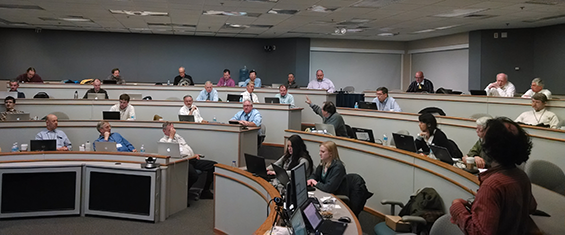2014 NOAA Satellite Science Week
This week researchers who develop products from weather satellite data and the stakeholders who will use them are gathering at the University of Wisconsin-Madison for the National Oceanic Atmospheric Administration (NOAA) Satellite Science Week. Participants are discussing future science directions and ensuring products and users are ready for the next generation of weather satellites: GOES-R on the geostationary side and Joint Polar Satellite System (JPSS) on the polar side. GOES-R is scheduled for launch in early 2016 while JPSS will launch a year later in 2017.
As one of the organizers of this year’s meeting, Tim Schmit, a NOAA Advanced Satellite Products Branch (ASPB) scientist stationed in Madison, commented on the selected location for this year’s meeting. Not only is Madison the birthplace of satellite meteorology, but it is also the location of the ASPB and the Cooperative Institute for Meteorological Satellite Studies (CIMSS). Both organizations have long successful histories in satellite remote sensing research and developing operational satellite products.
“It recognizes a lot of the work being done here,” he said.
Presenters and attendees from around the country (plus two international participants) were not limited to whether or not they can afford to travel as many of them are participating virtually – online and over the phone. Schmit estimated that attendance (roughly 100 at times) was fairly evenly split between those in person and those participating virtually. Organizing a virtual meeting allowed broader participation and representation from product developers and National Weather Service (NWS) regional offices, including those in Alaska and Hawaii.
Schmit noted, “There are a lot of advances going on in remote sensing in the United States and in the world, both on the polar side and on the geo[stationary] side… This is a meeting where we can really talk about the science.”
One of the highlights of NOAA Satellite Science Week, and what makes this meeting unique, is that it brings developers of geostationary and polar products together, giving them the opportunity to showcase their products’ capabilities to NWS representatives. In turn the hope is that these new capabilities and improved techniques will help forecasters provide more accurate and timely forecasts. At the same time the NWS has the opportunity to offer its perspective on what its forecasters need and can use.
“It’s this idea of marrying up a need with a solution,” said Schmit.
Discussions over the week are focused on applications, rather than broken down by satellite platform, from numerical weather prediction and data assimilation to exploitation of satellites for data sparse regions to hydrology to high impact weather (think severe storms and hurricanes) to terrestrial and ocean surface science to atmospheric structure and composition. CIMSS and ASPB scientists gave talks over a broad range of topics, including generating products specifically suited to the needs of forecasters in Alaska, predicting severe storms using probabilistic methods, detecting fires, and assimilating trace gas and aerosol retrievals for air quality forecasting.
Space Science and Engineering Center (SSEC) Executive Director for Science Wayne Feltz added that another key component of the meeting was providing an additional venue for those involved in operations at both the highest level and at the NWS office level to discuss ways to best work together to meet their individual missions, needs, and requirements. Schmit described it as a balancing act, bringing research products and innovation into the official operational system, noting how CIMSS has the ability to understand both sides and help navigate any issues that arise.
In conjunction with the meeting, Feltz noted that three independent review boards have been meeting in Madison in closed sessions to discuss each day’s presentations. The three boards are an Independent Advisory Committee, the NWS Operational Advisory Team, and the NOAA Science and Demonstration Executive Board. According to Feltz, each is charged with “setting the course for the next year as to where the science needs to go.” On Friday morning the review boards will share their findings with attendees.
While the meetings may end on Friday, discussions will no doubt continue as both sides seek to advance the science and the resulting products and find ways to use them, long after the launch of these new satellites.
by Leanne Avila

